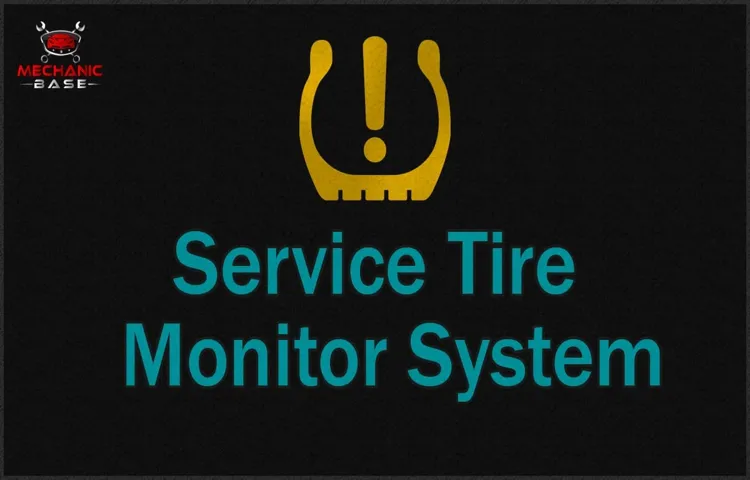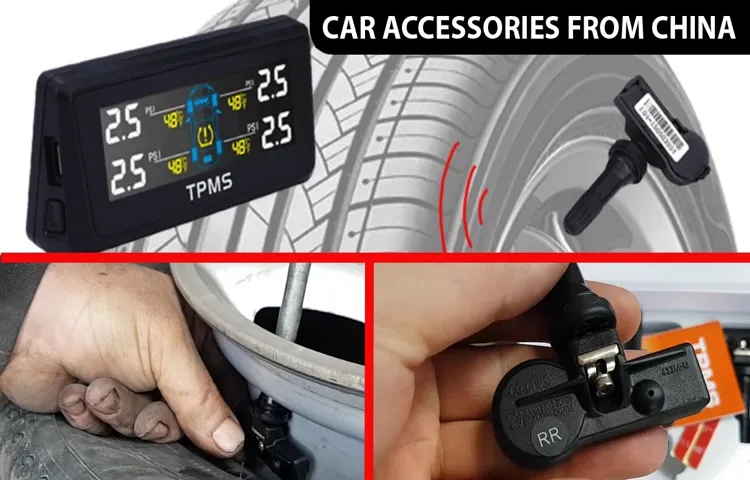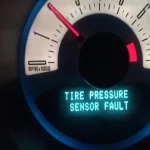If you’ve ever experienced a flat tire while driving, you know how inconvenient and potentially dangerous it can be. That’s why most modern vehicles come equipped with tire pressure monitoring systems (TPMS) to alert drivers when one or more tires have low pressure. But, like any other car component, TPMS requires servicing and maintenance to function properly.
In this blog, we’ll walk you through the steps you need to take to service your tire monitor system, ensuring your safety on the road and extending the lifespan of your tires. So buckle up and let’s get started!
Table of Contents
Introduction
If you’ve ever had a warning light appear on your dashboard indicating low tire pressure, then you’ve experienced the benefits of a tire monitor system. This technology has become standard in most cars today, as it helps prevent flat tires and improves safety on the road. But like any other system in your vehicle, it requires regular maintenance to function properly.
So how do you service a tire monitor system? First, make sure to check the batteries in each sensor, as they may need to be replaced. Additionally, check the valve stems in each tire to ensure they are in good condition and properly installed. If any sensors or valves need to be replaced, it’s important to use the correct parts for your specific vehicle.
Lastly, make sure to recalibrate the system after any maintenance is performed to ensure accurate readings. By taking these steps, you can ensure that your tire monitor system will continue to function properly and keep you safe on the road.
What is a tire monitor system?
A tire monitor system, also known as a TPMS (Tire Pressure Monitoring System), is an advanced technology that monitors the air pressure and temperature of your vehicle’s tires and sends real-time notifications to the driver regarding any fluctuations or disturbances. This may include visual or audible alerts, which can help you act efficiently and promptly to avoid potential accidents and increased fuel consumption resulting from low tire pressure. The sensors of the tire monitor system are typically installed on each of the four tires, and they continuously monitor the pressure and temperature.
With the help of advanced software and digital technology, the tire monitor system can alert the driver of any changes in pressure or temperature, helping them avoid accidents and improve overall driving safety. Having a tire monitor system installed in your vehicle not only increases your safety but also helps you save money on fuel costs, maintenance, and tire replacement.

Why is it important to service your tire monitor system?
When it comes to vehicle safety, one system that often goes overlooked is the tire monitor system. This system is responsible for monitoring the air pressure in your tires and alerting you if there’s a problem. Many people don’t realize just how important it is to service this system regularly.
By keeping your tire monitor system in good working order, you can ensure that your tires are at the proper pressure, reducing the risk of a blowout or other tire-related accident. Additionally, a well-functioning tire monitor system can help improve fuel efficiency, as underinflated tires can cause your vehicle to use more gas than necessary. So if you want to stay safe on the road and save some money on gas, it’s crucial to have your tire monitor system serviced regularly.
Step-by-Step Guide
If you’re wondering how to service your tire monitoring system, don’t worry! It’s not as complicated as it may seem. First, make sure your tires are properly inflated and check for any visible damage or wear. Next, locate the tire monitor system in your car – it’s typically located in the dashboard or center console.
Use the appropriate tool, such as a TPMS scanner, to read the system and diagnose any issues. If your system indicates a low tire pressure warning, fill the tire to the recommended level. If you receive a warning for a faulty sensor, you may need to replace it.
In any case, it’s important to regularly check and service your tire monitor system to ensure your safety on the road. Remember to consult your owner’s manual or a professional mechanic if you have any questions or concerns. By taking care of your tire monitoring system, you’ll have peace of mind knowing that your car is operating at its best.
Step 1: Check your owner’s manual
When it comes to maintaining your car, checking the owner’s manual is the first step you should take. Your owner’s manual contains all the information about your car that you would ever need, including the recommended maintenance schedule. This schedule outlines when you should get your oil changed, when to rotate your tires, and when to replace certain parts.
By following this schedule, you may be able to prevent costly repairs down the road. Moreover, the owner’s manual will also contain information on how to properly care for your car’s interior and exterior, as well as what fluids to use. It is important to keep your manual in a safe place and consult it regularly to get the most out of your vehicle.
So, before attempting any kind of DIY maintenance, start by checking your owner’s manual to ensure your car is running smoothly and safely.
Step 2: Inspect your tire monitor system
If you’ve noticed a warning light on your dashboard indicating a problem with your tires, the next step is to inspect your tire monitor system. This system uses sensors to detect pressure changes in each tire, letting you know when one or more tires are underinflated. The first thing to do is to check the tire pressure on all four tires with a reliable gauge.
If all the tires are within the recommended pressure range, take a closer look at the valve stems and the sensors themselves, as they may need to be replaced or tightened. It’s also important to ensure that the sensors’ batteries are fully charged and properly inserted. If you’re unsure how to troubleshoot your tire monitor system, refer to your owner’s manual or take your vehicle to a mechanic for assistance.
Don’t ignore a warning light when it comes to your tire health as it can put your safety at risk and can cause a costly tire replacement down the road.
Step 3: Check the tire pressure
When it comes to maintaining your car’s tires, checking the pressure is one step that should never be overlooked. Low pressure can lead to premature wear and tear and decreased fuel efficiency, while overinflation can make for an uncomfortable and unsafe ride. To properly check your tire pressure, you’ll need a tire pressure gauge, which can be found at any auto parts store.
First, remove the valve cap from the tire and press the gauge onto the valve stem, ensuring a tight seal. Take note of the reading and compare it to the recommended pressure listed in your car’s owner’s manual or on the inside of the doorjamb. If the pressure is too high or too low, use an air compressor to adjust it accordingly.
Doing so will not only prolong the life of your tires but also optimize your car’s performance on the road.
Step 4: Replace faulty components
Replacing faulty components is a critical step in ensuring the optimal performance and longevity of your device. Once you have identified the problem, the next step is to locate the faulty component and replace it with a new one. This may require some technical skills, especially if you need to open up your device and access the interior components.
If you are uncertain about how to proceed, it is best to seek the help of a professional repair technician. When sourcing new components, it is essential to ensure that they are compatible with your device, as using incompatible components can cause further damage and may void your warranty. By taking the time to replace faulty components, you can restore your device to full functionality and avoid costly repairs or replacement down the line.
So, next time your device acts up, remember to check for faulty components and replace them promptly to keep your device running smoothly.
Tools Needed for Servicing Your Tire Monitor System
Servicing your tire monitor system is an essential step in ensuring your vehicle runs smoothly and safely. To get started, you will need a few tools to make the process easier and more efficient. First, you will need a tire pressure gauge to check your tire pressure levels accurately.
It’s essential to have a reliable and easy-to-read gauge to prevent over or underinflating your tires. You will also need a valve core tool and a valve stem cap to remove the valve core and replace it after inspection. A tread depth gauge or a Penny Test will help you determine if your tires need replacement.
Additionally, a torque wrench is essential for tightening your lug nuts to the manufacturer’s recommendations. Using the right tools will ensure your tire monitor system operates correctly, extending the lifespan of your tires, and keeping you and your passengers safe on the road.
Pressure gauge
If you own a tire monitor system, it’s important to periodically service it to keep it functioning at its best. However, in order to service it, you’ll need a few important tools. One of the most important tools you’ll need is a pressure gauge.
This tool allows you to read the pressure levels in your tires, which is crucial for maintaining proper tire health and preventing potential blowouts. When choosing a pressure gauge, it’s important to make sure it’s accurate and easy to read. Additionally, you may want to consider getting a digital gauge that can also provide other information, such as tread depth.
By having a pressure gauge on hand, you’ll be able to quickly and easily check the pressure levels in your tires and take action if needed, ensuring your vehicle stays safe on the road.
Tread depth gauge
If you’re the type of person who likes keeping their car in top shape, then servicing your tire monitor system should be a regular part of your routine. Besides ensuring that the tires are properly inflated, you will also need some tools to check the tread depth gauge. A tread depth gauge is a small tool designed to measure the depth of tire treads.
It’s essential for maintaining safe driving conditions since tires with worn-out treads are more susceptible to accidents. You can easily purchase one at an auto supply store or online marketplace, and it’s not costly. The tool is pretty simple to use; insert the probe into the grooves of your tire and align it with the tread block.
Then, read the measurement from the gauge and compare it to the minimum tread depth requirements of your tire. Keeping your tire treads in check will ensure that you enjoy safe and reliable driving performance, especially on wet and slippery roads.
Valve stem tool
If you own a vehicle with a tire pressure monitoring system (TPMS), eventually, you will need to service it. Having the right tools can make servicing your TPMS much easier. One tool you will need is a valve stem tool.
This tool is essential for removing and installing valve stems on your tires. The valve stem is a critical component of your TPMS, as it houses the sensor that measures your tire pressure. If your TPMS is sending false alerts, it could be due to a faulty valve stem.
Without a valve stem tool, servicing your TPMS can be frustrating and time-consuming. Therefore, it’s essential to have a valve stem tool in your tire maintenance kit. Once you have it, you’ll be able to quickly and easily service your tires’ valve stems, ensuring that your TPMS continues to function properly.
With the right tools, any maintenance task becomes much more manageable, and your TPMS is no exception.
Replacement parts
If you’re looking to service your tire monitor system, there are some tools that you will need to have on hand. First and foremost, you will need a tire pressure monitoring system reset tool. This tool is necessary to reset the system and clear any error codes that may be present.
Additionally, you’ll need a tire pressure gauge to accurately measure the pressure in each tire. It’s a good idea to have a tire tread depth gauge as well, so you can make sure your tires are wearing evenly. Finally, you may need a valve stem removal tool if one of your valve stems is damaged and needs to be replaced.
By having these tools on hand, you’ll be able to service your tire monitor system quickly and easily, ensuring that your vehicle stays safe and running smoothly.
Conclusion
Servicing a tire monitor system is all about letting your car’s brain know that you care about its well-being. By regularly checking your tire pressure, testing the sensors, and replacing faulty parts, you provide your vehicle with the TLC it needs to keep rolling smoothly. So, whether you’re a tire-servicing ace or a newbie mechanic, remember that taking care of your tire monitor system is like giving your car a big hug – it shows how much you appreciate all the miles it helps you drive!”
Regular servicing of your tire monitor system saves you time and money.
Regular servicing of your tire monitor system is highly recommended to ensure that it operates as it should. This not only saves you time, but it also saves you money in the long run as it helps identify potential issues before they escalate. Performing regular maintenance requires a few specific tools, such as a tire pressure gauge, a lug wrench, and an air compressor.
With a tire pressure gauge, you can check that your tires are inflated to the right pressure level, which is indicated in your vehicle manual. The lug wrench is useful in case you need to remove a tire, and the air compressor enables you to top up any tires that require extra air. By having these tools readily available and using them regularly, you can prevent potential issues with your vehicle’s tire monitor system and extend the overall lifetime of your tires.
This, in turn, allows you to save money by avoiding costly repairs or replacements. Remember, taking care of your tires not only saves you money but also ensures that you’re safe on the road.
FAQs
What is a tire monitor system?
A tire monitor system is a tool that monitors the air pressure inside the tires.
How often should I service my tire monitor system?
You should service your tire monitor system every time you get your tires changed or rotated.
Can I service my own tire monitor system?
Yes, you can service your own tire monitor system by following the instructions in your vehicle’s manual.
What are the benefits of having a tire monitor system?
Having a tire monitor system can help improve fuel efficiency, extend tire life, and prevent accidents due to underinflated tires.
How does a tire monitor system work?
A tire monitor system uses sensors inside the tires to relay air pressure and temperature information to the car’s computer. The computer then alerts the driver if there is an issue.
What are the most common issues with tire monitor systems?
The most common issues with tire monitor systems are faulty sensors, low battery levels, and incorrect readings due to dirty or damaged sensors.
Do all cars come equipped with a tire monitor system?
No, not all cars come equipped with a tire monitor system. It is typically found in newer cars or as an optional feature.



